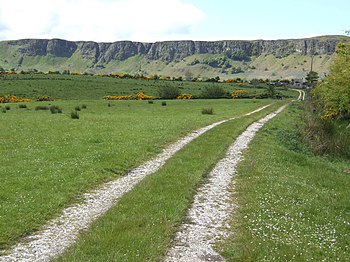Sallagh Braes

The Sallagh Braes are a vast natural amphitheatre of cliffs in County Antrim, part of the Antrim Hills south of the famed Glens of Antrim.
The braes are in the form of a horseshoe of cliff or escarpment plunging down to the farmland below, the maw of the semicircle facing toward the sea. Atop is wind-scoured heath of course grass and thistle but below a flat landscape sheltered by the scarp.
The Ulster Way passes across the top of the braes on its way between the Glens and Belfast
This is a wildlife habitat, and ravens and buzzards may be watched hunting from the cliff edge.
Geology
The large, semi-circular cliff seems to be the result of a huge landslip in the ancient past, a combination of underlying geology and Ice Age glaciers. The cliffs are composed of hard rocks (basalt and chalk), underlain by softer rocks (particularly Jurassic mudstone), making them very unstable. It is thought that at the end of the last Ice Age and the drawing back of the ice, the unsupported cliffs became were prone to huge landslips which caused the form visible today.
Wildlife

The braes appear to be a neat semi-circle but they contain a complex set of cliffs, ravines and scree, and are composed of a combination of basalt and limestone, which provides a wide variety of wildlife habitats, along with neighbouring Knock Dhu. The two are recognised as of the most important sites in Northern Ireland for mosses, with a number of rare species. A small population of brown screw-moss was found a few years ago on limestone cliffs at Sallagh Braes which species was thought to be extinct on Ireland, having not been recorded since 1962.
Outside links
- Knock Dhu and Sallagh Braes AONB – DOE-NI